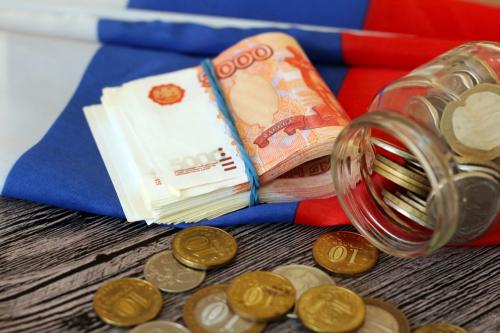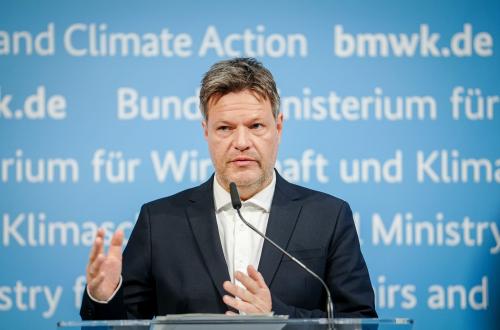The notion that oil-consuming nations should organize a buyers’ cartel to cap the price of oil—promoted by U.S. Treasury Secretary Janet Yellen and recently endorsed by the leaders of the Group of Seven—sounds fanciful. After all, if this were workable, why didn’t we do it years ago to bring down oil prices?
In fact, this is a creative and perhaps even practical response to two unusual imperatives. The first is well covered by the press: to reduce the flow of oil revenues that are financing Russia’s war machine. The second is not: to prevent an economically catastrophic increase in oil prices because of one element of European sanctions set to take effect at the end of this year.
Oil prices fell to $20 a barrel at the beginning of the pandemic in 2020, returned to pre-pandemic levels of around $60 a barrel in early 2021 as the economy recovered, and then spurted above $100 a barrel after Russia invaded Ukraine. The European Union, the U.S., Canada, and the U.K. have agreed to stop buying (most) Russian oil, but Russia is still selling huge volumes—albeit at a discount from the world price—to India, China, and other energy-thirsty economies. Russia normally accounts for about 10% of global oil production, but its exports have been reduced since its invasion of Ukraine. Today, U.S. officials estimate that ocean-going tankers carry about 70% of Russia’s 5.6 million barrels a day of crude oil exports. (The rest goes through pipelines, roughly half towards Europe and half towards China.)
One textbook solution to keeping oil flowing from Russia but reducing its revenues would be for major importers to impose a tariff on Russian oil. Because oil is a global market, consumers would pay the going world price, but Russia would receive the world price minus the tariff; the tariff revenue could, for instance, be used to aid Ukraine. Secretary Yellen floated that idea, but it didn’t go anywhere. An international agreement to cap the price of Russian oil is an alternative. Russia could, of course, simply refuse to sell oil, but, in theory, if the cap is set above Russia’s marginal cost of production, it would have an incentive to keep pumping.
But there’s more to the story than oil buyers’ talk of a ceiling on the price they’re willing to pay for Russian oil. At the beginning of June, the European Union agreed to bar its companies from “insuring and financing the transport, in particular through maritime routes, of [Russian] oil to third parties” after the end of 2022 to make it “difficult for Russia to continue exporting its crude oil and petroleum products to the rest of the world.” The U.K. agreed to go along.
This is a big deal because European and British companies account for about 85% to 90% of the business of insuring, reinsuring, and financing seaborne Russian oil. Owners of oil tankers of any nationality will refuse to carry Russian oil if they can’t get high-grade insurance. The operators of the Suez Canal, for instance, don’t permit uninsured ships to sail through the vital channel. Russia, in response, says its state-owned insurance company will provide the reinsurance that British and European firms won’t. But Russian firms don’t have the same reputation as the British and European insurers, and their coverage may not be accepted by major ports and canals; the same is true for Indian and Chinese insurers.
Okay, so this insurance ban would hurt Russia by reducing its oil exports. But the resulting restriction on the supply of oil flowing to world markets would drive the price even higher than it is already. The Brent benchmark price was above $100 a barrel at the beginning of July 2022. Analysts at Barclays say that disrupting Russia’s seaborne crude exports could push oil prices above $200 a barrel. The insurance ban “would have further-reaching consequences for the oil market than the EU oil embargo,” Commerzbank analyst Carsten Fritsch told the AFP wire service.
American officials are understandably reluctant to criticize their European and British allies for the well-intentioned if poorly conceived decision to ban their firms from insuring and financing seaborne shipments of Russia oil.
So U.S. Treasury officials devised a way to prevent this sanction from tanking the world economy: Exempt from the finance and insurance ban any shipments of Russian oil that are sold for less than some publicly-set price.
This would allow the ban to remain in place—undoing it is seen as politically impossible—while preventing it from taking full effect and triggering a devastating spike in oil prices. The only reason this has a chance of working is that the British and European companies largely control the insurance and financing market for oil tankers, and, particularly, ships that carry refined petroleum products. It is not a scheme that could work for other commodities or in other markets.
A very big question is whether this can be implemented. India and oil-importing developing countries would have strong incentives to go along if the cap would reduce the price they pay for oil, though it’s not clear that China, a major buyer of Russian oil, would cooperate.
There is plenty of well-justified skepticism. This plan would require reopening the sanctions agreement that European leaders only recently negotiated, and some of them see this approach as diluting those sanctions. Russia could refuse to export oil at the lower price, though that would not only cut off one of its few sources of external revenue, it also would require shutting down oil wells that aren’t easily restarted. (An extended shutdown of Russian oil wells would do severe and lasting damage to its production capacity, says Craig Kennedy, a Harvard expert on Russia’s oil industry. He advocates what he calls “a smart embargo option that could stem the flow of Russian tax revenues from oil exports while also averting a politically risky global supply shock.”
And, of course, there would be some cheating. Russia might agree to a cap of, say, $50 a barrel but deliver the oil only if a buyer in, say, India also agrees also to buy shiploads of used shoes or scrap paper worth another $50 a barrel. Or some country could secretly offer to buy Russian oil at $51 or $52 barrel. That would weaken the stringency of the price cap, but buyers would be negotiating up from, say, $50 a barrel instead of negotiating a discount down from today’s $100-plus world price, as they’re doing now.
But the unpleasant alternative to the U.S.-devised plan is to allow the European and British ban on financing and insuring tankers carrying Russian oil take effect at year-end, which would curtail Russia’s exports but also push world oil prices so high that a painful global recession would likely ensue.
The Brookings Institution is financed through the support of a diverse array of foundations, corporations, governments, individuals, as well as an endowment. A list of donors can be found in our annual reports published online here. The findings, interpretations, and conclusions in this report are solely those of its author(s) and are not influenced by any donation.
The Brookings Institution is committed to quality, independence, and impact.
We are supported by a diverse array of funders. In line with our values and policies, each Brookings publication represents the sole views of its author(s).







Commentary
The story behind the proposed price cap on Russian oil
July 5, 2022